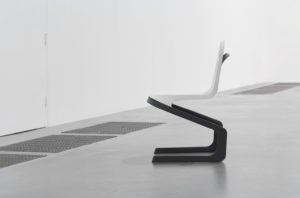At this year’s Royal College of Art graduation show, industrial designer Frederic Rätsch is presenting a visual design concept of flexible seating in public spaces, developed in collaboration with DuPont Performance Materials.
The project aims to create an injection moulded chair for public spaces and the contract market.
Rarely does public seating offer comfort, aesthetics and robustness, all at the same time.
To address this dilemma, Rätsch and specialists from DuPont Performance Materials started working on the project ‘Flexible Seating in Public Spaces’ in October 2016, initiated as his graduation project in Design Products at the Royal College of Art in London.
Rätsch envisioned a flexible cantilever chair – the most challenging category of chair – that would combine unique design with innovative sitting and stacking benefits.
For him, products need to be durable, produced in high quality with a strong character, allowing the user to identify with it and to build up an enduring relationship.
Working with the material experts at Dupont, he came up with a concept for a double cantilevered chair made from DuPont’s Crastin PBT, which provides the structural firmness support the seat shell, while still allowing some flex, and Hytrel TPE, for enhanced softness, pleasant touch-and-feel of the seating and backrest surface, both of which adapt to the body.
According to Andreas Zöller, DuPont Marketing and Innovation Leader EMEA, the project presented a challenge to Dupont, as well.
“Bringing deep understanding of material properties, functional and aesthetic design concepts on one table has been energizing and enabled us to push the limits in our minds,” he said.
In the final phase of the development the Institute of Plastic Processing (IKV) of the RWTH Aachen University, Germany, manufactured a full-scale prototype on their large 3D printing assets, using Hytrel for the seat shell to showcase the intended flexibility.
Using fused filament fabrication and DuPont’s new, low-warpage engineering filaments, the IKV successfully produced a full-size 3D printed chair.



